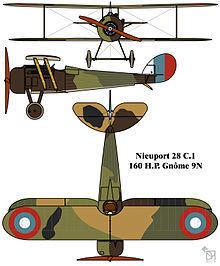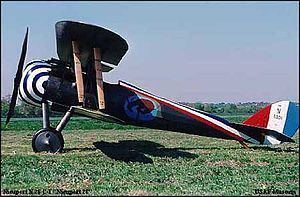Top speed 184 km/h Wingspan 8.15 m Weight 475 kg First flight June 14, 1917 | Range 349 km Length 6.5 m Engine type Rotary engine | |
 | ||
Nieuport 28 n 28c 1 rc biplane explained
The Nieuport 28 C.1 was a French biplane fighter aircraft flown during World War I, built by Nieuport and designed by Gustave Delage. Owing its lineage to the successful line of sesquiplane fighters that included the Nieuport 17, the Nieuport 28 continued a similar design philosophy of a lightweight and highly maneuverable aircraft.
Contents
- Nieuport 28 n 28c 1 rc biplane explained
- Design and development
- Nieuport 28A
- Operational history
- Postwar
- Survivors
- Replicas
- Operators
- Specifications
- References

By the time the Nieuport 28 was available, the SPAD XIII had been chosen to equip the escadrilles de chasse of the Aéronautique Militaire for 1918, and this fighter was also the first choice for the projected American "pursuit" squadrons. In the event, a shortage of SPADs led to Nieuport 28s being issued to four American squadrons between March and August 1918, and these became the first aircraft to see operational service with an American fighter squadron.
Nieuport 28s saw considerable post-war service: in particular 50 from a second batch ordered later were "returned" to America, and as well as army and naval service these found civilian use, especially in Hollywood films.

Design and development

By the middle of 1917, it was obvious that the Nieuport 17 and its immediate developments such as the Nieuport 24bis, with only moderate performance gains, were unable to offer sufficient improvements to deal with the latest German fighters. The Nieuport 17 line was already being supplanted in French service by the SPAD S.VII as quickly as supplies of the Hispano-Suiza engine would allow.
The Nieuport 28 design advanced the concept of the lightly built, highly maneuverable rotary engined fighter typified by the Nieuport 17 to the more demanding conditions of the times. It had a more powerful engine, twin machine guns, and a new wing structure – for the first time, a production Nieuport fighter was fitted with conventional two-spar wings, top and bottom, in place of the sesquiplane "v-strut" layout of earlier Nieuports. Ailerons, controlled with torque tubes were fitted to the lower wings only. The design of the tail unit closely followed that of the Nieuport 27, but in order to provide a more streamlined profile, the fuselage was longer and slimmer, so narrow that its twin Vickers machine guns were offset to port, one between the cabane struts and one just outboard of them. Several prototypes were built - testing three different dihedral settings for the top wing, including a completely flat wing, and one with marked dihedral that rested very close to the top of the front fuselage. Production machines had an intermediate configuration, with a slight dihedral in the upper wing, taller cabane struts, and room for the second machine gun to be mounted under the center section.
Aside from the original three variants, additional prototypes were built to test a wooden monocoque fuselage and alternate engine installations including the 300 hp Hispano-Suiza 8Fb, 170 hp Le Rhône 9R, 275 hp Lorraine-Dietrich 8Bd and 200 hp Clerget 11E. The results of these tests facilitated the development of the Nieuport 29.
Nieuport 28A
In late 1918, about the time that the type was withdrawn from front line use, the U.S. Army placed an order for an additional 600 improved Nieuport 28s, which were given the American designation 28A. Although these were mainly intended as advanced trainers, early problems with the SPAD S.XIII in American service meant that the possibility of re-introducing the Nieuport fighters into squadron service was not discounted, and provision was made for the installation of twin M1917/M1918 Marlin guns, mounted side by side under the center section. The Nieuport 28A was to feature an improved upper wing leading edge structure and a redesigned fuel system, correcting faults in the initial production batch. As the Nieuport company were preoccupied with later types, production was undertaken by Lioré et Olivier who had built 170 Nieuport 28As and parts for another 100 by the end of the war, with the remainder of the order being cancelled.
Operational history
By early 1918, when the first production examples of the Nieuport 28 became available, the SPAD S.XIII was already firmly established as the standard French fighter, and the Nieuport 28 was "surplus" from the French point of view. On the other hand, the United States Army Air Service was desperately short of fighters to equip its projected "pursuit" (fighter) squadrons. Since the SPAD S.XIIIs the Americans actually wanted were initially unavailable due to engine shortages, the Nieuport was offered to the American Expeditionary Force (AEF) as an interim alternative.
A total of 297 Nieuport 28s were purchased by the Americans (none of our sources make it clear if this refers only to the initial order, or includes Nieuport 28A trainers accepted from the late 1918 contract). The 94th and 95th Aero Squadron received the initial allotments, starting in March 1918. In all, four AEF pursuit squadrons: the 27th, 94th, 95th and 147th Aero Squadrons, flew Nieuport 28s operationally for various periods between March and August 1918.
The factory delivered the Nieuport 28s to the Americans in mid-February 1918 without armament. At the time the AEF had no spare Vickers machine guns to supply to the squadrons, so that the first flights were unarmed training flights for pilots to familiarize themselves with the handling and performance of the new type. When deliveries of Vickers guns to the American squadrons finally started in mid-March, and until sufficient guns had been received for all of the fighters to be fully equipped, some aircraft were flown on patrol with only one machine gun fitted.
On 14 April 1918, the second armed patrol of an AEF fighter unit resulted in two victories when Lieutenants Alan Winslow and Douglas Campbell (the first American-trained ace) of the 94th Aero Squadron each downed an enemy aircraft over their own airfield at Gengoult. Several well-known World War I American fighter pilots, including the 26-victory ace, Captain Eddie Rickenbacker, began their operational careers on the Nieuport 28. Quentin Roosevelt (the son of U.S. president Theodore Roosevelt) was shot down and killed flying the type.
The 94th and 95th had the task of dealing with the type's teething troubles. Initially undercarriages failed on landing - this was corrected by using heavier bracing wire. The Nieuport 28's 160 hp Gnome Monosoupape rotary engine and fuel system proved unreliable and prone to fires. Field improvements to fuel lines, and increased familiarity of the American pilots (and their ground crews) with the requirements of monosoupape engines reduced these problems, but the definitive solution adopted was simply not completely filling the reserve fuel tank, at the expense of range. More seriously, a structural problem emerged – during a sharp pull out from a steep dive, the plywood leading edge of the top wing could break away, taking the fabric with it. On the whole, although the pilots of the 94th and the 95th appreciated the manoeverability and good handling of the Nieuport, and were reasonably happy with its general performance, they regarded the type as fragile and dangerous.
The 27th and 147th Aero Squadrons arrived at the front three months later, starting combat operations on 2 June 1918. In July 1918, the 94th and 95th Aero Squadrons received their first SPAD XIIIs and some of their surviving Nieuport 28s were then transferred to the 27th and 147th Aero Squadrons. By the end of August 1918, all four American squadrons were fully outfitted with SPAD XIIIs. The pilots of the 94th and 95th Aero Squadrons welcomed the SPADs, although the 27th and 147th Aero Squadrons were much less enthusiastic about the change.
Twelve of the Army Nieuports were transferred to the U.S. Navy which equipped them with Royal Navy style hydrovanes and wing floatation gear, and flew them from launching platforms mounted above the forward turrets of eight battleships, in the same way that Sopwith Camel 2F.1s were used by the British Grand Fleet.
Postwar
Postwar, approximately 50 new Nieuport 28As which had not previously seen service were shipped to the U.S. During the 1920s, Nieuport 28s were also in service with various air forces; Switzerland obtained 15, while Argentina received a couple of aircraft. Switzerland acquired its examples in 1919, and continued to fly the type throughout the 1920s, retiring their last Nieuport 28s from active service in 1930.
During the same period, a number of Nieuport 28s made their way to Hollywood where they appeared in the movies, The Dawn Patrol (1930), as well as its remake in 1938, Ace of Aces (1933) and Men with Wings (1938). The Nieuport 28s appeared in several later films set during World War I, including the Lafayette Escadrille (1958).
Survivors
Along with the replicas, a number of original surviving aircraft are found in museum collections worldwide. Original airframes are located in the Fliegermuseum in Dübendorf, and the Swiss Transport Museum in Lucerne, Switzerland, a U.S. Navy Nieuport 28 at the National Naval Aviation Museum in Pensacola, Florida and the Smithsonian's Steven F. Udvar-Hazy Center of the National Air and Space Museum,
Replicas
In the early 1930s, as the supply of original Nieuport 28s began to diminish, the Garland-Lincoln LF-1 (Lincoln-Flagg-1) was built in Glendale, California specifically to represent a generic World War I fighter for movie stunt work. While very similar in general appearance, the LF-1 was shorter than a genuine "28", had a steel tube framework, a one-piece upper wing without dihedral, and was fitted with a more powerful 200 hp (149 kW) Wright J-4-B radial engine. A Garland-Lincoln LF-1 (N12237) was featured in Hell in the Heavens (1934), Dawn Patrol (mixed in with authentic Nieuport 28s) (1938), and Men with Wings (1938). It was later used by Frank Tallman and Paul Mantz for other film and television work.
In more recent times, the Nieuport 28 has become a favorite subject for homebuilders wishing to recreate a World War 1 fighter, as its wood construction (some replicas substitute a metal tube fuselage), light weight and availability of modern engines such as the Rotec R3600 nine cylinder radial, have led to number of replicas being offered as kits.As of 2012, a number of home-built replicas have taken to the air.
Reproductions are found at the San Diego Air & Space Museum, National Museum of the United States Air Force at the Stampe et Vertongen Museum in Belgium. and at the Airbase Arizona Museum of the Commemorative Air Force at Falcon Field (Arizona), near Mesa, AZ. A flying replica in Eddie Rickenbaker's colors is found at the Great War Flying Museum, Brampton Airport in Caledon, Ontario, Canada.
Operators
Specifications
General characteristics
Performance
Armament
